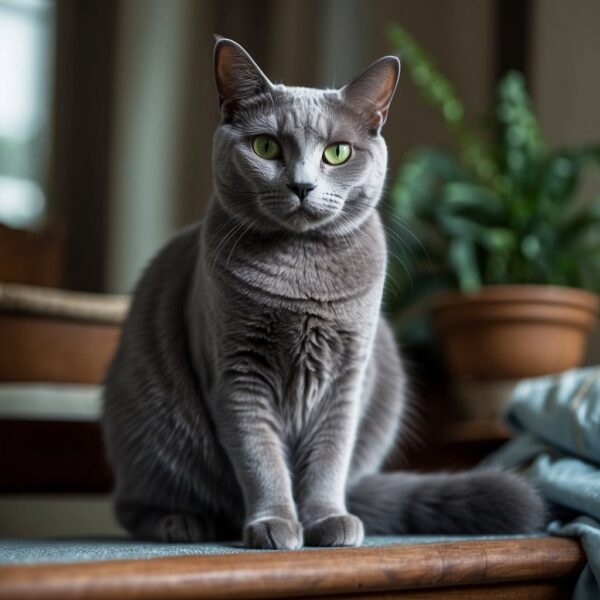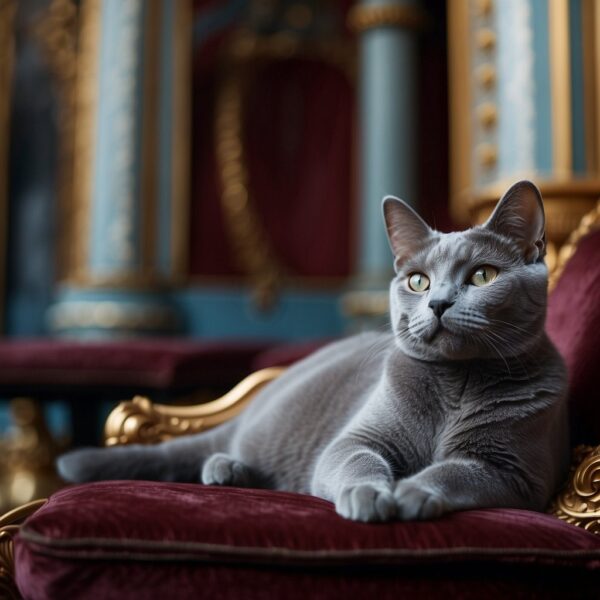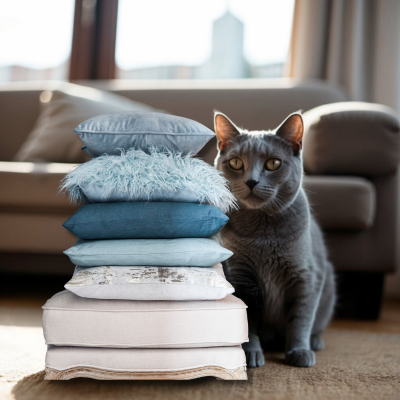
Russian Blue Cat: A Beloved Breed
The Russian Blue Cat is a distinct breed known for its plush blue-grey coat and bright green eyes, exuding elegance and a regal demeanor. With origins that are believed to trace back to the port town of Arkhangelsk in Russia, they are admired not just for their striking appearance but also for their gentle and friendly nature. Not only are they a visual delight, but they also make for affectionate and loyal companions, endearing themselves to their guardians with their subtle charm and reserved yet sociable temperament.
These cats are characterized by a dense, soft double coat, which further accentuates their slender, muscular frame, giving them a noble silhouette. This beautiful fur paired with a sweet-tempered and quiet personality makes them a preferred choice for a range of cat enthusiasts. Beyond their looks, they are also known for being intelligent and curious, traits that contribute to their playful and interactive behavior. They thrive in stable environments and form close bonds with their families, often becoming particularly attached to one person.
Key Takeaways
- Russian Blue Cats are elegant, with a blue-grey coat and green eyes.
- They are known for being gentle, affectionate, and loyal companions.
- These cats are intelligent, playful, and bond closely with their families.

Origin and History of Russian Blue Cats
The Russian Blue cat boasts a storied past grounded in its Russian heritage, significant European prominence, and eventual transatlantic migration to America, rightfully earning its place among esteemed cat breeds.
Russian Roots
Originating from Russia, specifically the port city of Arkhangelsk on the Archangel Isles, the Russian Blue is believed to have been a pet among the Russian Czars. The natural beauty and poised demeanor of these cats quickly made them a coveted breed in their homeland.
Migration to Europe
The breed’s migration to Europe is attributed to sailors who transported them from the Archangel Isles during the 1800s. Their arrival in England marked the onset of the Russian Blue’s international recognition, with their first recorded appearance being at the Crystal Palace in London in 1871.
The Archangel Cat
In Europe, the Russian Blue was often referred to as the Archangel Cat or Archangel Blue, nodding to their geographical and historical origins. These cats distinguished themselves with their signature blue-gray coat and striking green eyes, capturing the hearts of cat enthusiasts.
Expansion to America
The United States saw the introduction of the Russian Blue in the early 20th century, where they continued to charm with their sophisticated appearance and gentle nature. Post World War II, the breed’s population in Europe waned, which led to crossbreeding with the Siamese to preserve its lineage.
russian blue Breed Characteristics
The Russian Blue is a cat breed renowned for its distinctive physical features, particularly its plush blue coat and striking green eyes, which convey an air of elegance and poise.
Physical Attributes
Russian Blues are medium-sized cats exuding grace with a fine-boned structure and long, slim bodies. Their elegant appearance is accentuated by a pair of long, tapering tails and a head with a flat skull. Typically, male Russian Blues may weigh between 10 to 14 pounds, while females are generally lighter.
- Height: 8-10 inches
- Weight: 7-12 pounds
- Body: Slender and elongated
- Tail: Long and tapering
- Head: Flat skull, fine-boned facial features
Coat and Color
The coat of a Russian Blue is one of its most captivating features. It’s a short, dense, and plush double coat standing out from the body, soft to the touch. The coat color, which is the breed’s namesake, is a consistent, even, and vivid blue with each hair tipped with silver, lending the coat a shimmering quality.
- Coat Length: Short
- Coat Texture: Dense, plush
- Coat Colors: Uniformly steel blue with silver tips
Distinctive Green Eyes
One of the most arresting features of Russian Blues is their vibrant green eyes, which are large, round, and expressive. The brightness of the green contrasts strikingly with the blue of their coat, making their gaze particularly enchanting.
- Eye Color: Vivid green
- Eye Shape: Large and round

Russian Blue Cat Temperament and Behavior
Russian Blue Cats are renowned for their composed temperament and graceful behavior, often displaying a mix of playfulness and independence. These cats blend intellect with a sociable disposition, making them fitting companions for a variety of homes.
Social and Playful Nature
Russian Blue Cats exhibit a playful side, enjoying interactive toys and games that challenge their intelligence. They thrive in environments where they’re provided with ample mental stimulation, which keeps them engaged and content. It’s not uncommon to find them chasing a ball or pouncing on a feather toy, reflecting their playful and intellectual needs.
- Playfulness: Essential for daily exercise and engagement
- Intelligence: Highly capable of learning tricks and solving puzzles
Compatibility with Families
Typically, Russian Blues are quiet and affectionate towards their family, often forming a loyal bond. Their friendly nature makes them good companions for children and adults alike, although they may exhibit shyness around strangers. The breed’s beautiful appearance combined with their gentle demeanor fits well into family settings.
- Affectionate: They form strong attachments to their family members
- Friendly: They are amiable with familiar people, but may need time with new acquaintances
Independent Streak
While being social and loving, Russian Blues also cherish their independence. They can entertain themselves and are often content in having some alone time, which should be respected by their parents. This independent streak allows them to patiently wait for their parents and should not be mistaken for aloofness.
- Independent: Capable of self-amusement and doesn’t demand constant attention
- Temperament: Balanced nature between companionability and self-sufficiency
Russian Blue Cat Health and Care
The Russian Blue cat is known for its striking appearance and independent character. Ensuring their health and well-being involves routine grooming, proper nutrition, and regular exercise. Vigilance in these areas helps prevent common health issues and promotes a healthy life.
Physical Exercise
Russian Blues are intelligent and active cats, requiring regular exercise to maintain a healthy weight. They enjoy interactive play and can be trained to fetch, which also serves as mental stimulation. Exercise should be a daily routine to prevent obesity, a condition to which this breed can be prone due to its hearty appetite.
Grooming Needs
This breed has a dense double coat that is plush and short. Regular grooming is essential to keep their coat healthy and to reduce shedding. They typically require brushing once or twice a week, which helps distribute natural skin oils and remove loose hair. During the spring and fall, they may shed more, so increasing the frequency of grooming during these periods can be beneficial.
Common Health Issues
Russian Blues are a generally healthy breed with a lifespan of up to 20 years, but like all cats, they may be susceptible to certain health conditions:
- Obesity: Given their propensity for overeating, it’s important to monitor their diet closely to prevent weight gain.
- Kidney Disease: They can be at risk for genetic conditions such as Polycystic Kidney Disease (PKD).
- Progressive Retinal Atrophy (PRA): A hereditary disease which can lead to blindness. Regular check-ups with a veterinarian can help early detection and management.
A balanced diet tailored to their nutritional needs and routine veterinary visits are key in keeping this breed healthy. Although they are known for being somewhat hypoallergenic, allergies may still be a concern for sensitive individuals. It’s always best to spend time with the breed to see if any allergic reactions occur.
Maintaining the health and care of a Russian Blue requires attention to their specific needs in terms of exercise, grooming, and diet, along with awareness and prevention of breed-related health issues.
Integration with Other Pets
When considering the successful integration of Russian Blue Cats with other pets, it is essential to plan interactions and introductions carefully. Their temperaments allow for peaceful coexistence with a variety of animals, but the key to harmony lies in structured and gradual introductions.
Getting Along with Dogs
Russian Blue Cats can live harmoniously with dogs when properly introduced. It is crucial to consider the personality of both the dog and the cat, as well as the dog’s breed and temperament. Some dogs have a higher prey drive and may not be suitable companions for a Russian Blue. Introduce them in a controlled environment, closely monitoring their behavior towards each other:
- Initial Encounter: Keep the Russian Blue in a separate room, allowing them to smell each other under the door.
- Face-to-Face Introduction: Use a baby gate or a leash to control the dog’s approach.
- Supervised Interaction: Gradually allow more interaction, under supervision, until both pets are comfortable.
Interaction with Other Cats
Russian Blue Cats typically engage well with other felines. They are social creatures and can form meaningful bonds with their kind. The integration process with other cats should focus on slow and careful introductions:
- Scent Exchange: Swap bedding or toys between cats to get used to each other’s scent.
- Controlled Visibility: Allow the cats to see each other through a glass door or a slightly open doorway.
- Shared Space: Supervise short periods of time together in the same room, extending time as they show signs of comfort.
Consideration for Small Pets
The instinctual behavior of Russian Blue Cats towards small pets, such as birds or rodents, may pose a risk. These cats may exhibit a hunting instinct. Safeguards should be in place when introducing them to smaller animals:
- Caged Protection: Keep small pets in their cages during initial stages.
- Observation: Watch the Russian Blue’s reactions closely for signs of predatory behavior.
- Secure Environment: If the cat exhibits too much interest, it may be best to keep them separated permanently.
Training and Entertainment
Russian Blue Cats are highly intelligent and respond well to engaging play and structured training, ensuring their physical and mental well-being.
Engaging Intelligence with Toys
Toys are essential for stimulating the Russian Blue’s instinctual hunting behaviors and keeping their active minds engaged. Incorporating tunnels into their playtime allows them to explore and satisfy their natural curiosity.
- Toy Recommendations for Russian Blues:
- Wand toys for chase games
- Puzzle feeders for mental stimulation
- Tunnels to replicate hiding and hunting scenarios
Training for Skill Development
Training a Russian Blue Cat taps into their capacity for learning and strengthens the bond between the cat and their guardian. Simple commands like ‘sit’ or ‘stay’ can be taught, utilizing treats as rewards for compliance. To prevent unwanted scratching and to maintain healthy nails, introducing a scratching post early on is critical. With patience and consistency, Russian Blue Cats can be trained to use these designated areas for their scratching needs.
- Components of Effective Training:
- Use positive reinforcement with treats
- Encourage use of a scratching post to protect furniture
- Incorporate play that allows climbing to exercise natural feline inclinations

Living with a Russian Blue
Living with a Russian Blue cat can be a delightful experience for those who prefer a cat with a predictable routine and a tranquil presence at home. These fine-boned, elegant cats are noted for their loyalty and somewhat hypoallergenic coats, making them a potential option for individuals with mild cat allergies. While they are reserved and enjoy peace, they also thrive in a loving environment tailored to their needs.
Daily Routines
Russian Blue cats appreciate consistency and benefit from a structured daily routine. They typically adjust well to the schedules of their human companions, demonstrating their loyal nature. Cat parents should establish regular feeding times, grooming sessions, and playtime to keep these intelligent cats both physically and mentally stimulated. Here’s a brief overview of a typical day:
- Morning: Serve the first meal at a consistent time each morning.
- Daytime: Provide puzzle toys or safe outdoor access if possible for activity.
- Evening: Engage in a play session, followed by grooming and the last meal of the day.
Maintaining the same routine every day helps to build trust and a sense of security for the Russian Blue.
Creating a Pet-Friendly Environment
A pet-friendly environment is crucial for the wellbeing of a Russian Blue. They favor calm and stable atmospheres, often retreating to a quiet corner if the household becomes too lively. A few essentials to include in their environment are:
- A cozy bed in a quiet spot
- Scratching posts to maintain their claws and stretch their muscles
- Perches or cat trees for observation and retreat
- Filtered water to encourage hydration
Parents should also consider investing in quality air filters if allergies are a concern, as Russian Blues shed less than many other breeds, but are not entirely allergen-free. While considering costs, potential parents should prepare for an initial investment between $1,000 to $1,700 for a purebred cat, with ongoing expenses for high-quality food, healthcare, and accessories to ensure a lifespan that can reach up to 20 years.
Frequently Asked Questions
In this section, readers will find concise answers to common questions regarding the maintenance, behavior, size, and cost of Russian Blue cats.
What personality traits are common in Russian Blue cats?
Russian Blue cats are known for their affectionate and loyal nature. They are intelligent and reserved, typically showing shyness around strangers but are deeply connected to their family members.
How does one care for a Russian Blue kitten?
Caring for a Russian Blue kitten involves providing a balanced diet, regular grooming to maintain their dense coat, and ensuring they have adequate playtime for mental and physical stimulation.
What is the average size of a Russian Blue cat?
The average size of an adult Russian Blue cat ranges from 7 to 12 pounds in weight with a sleek body and fine-boned structure, making it a medium-sized breed.
Can Russian Blue cats exhibit aggressive behavior?
Russian Blue cats are generally not aggressive; they are known for their calm and docile demeanor. However, like any cat breed, individual behavior may vary.
How much typically does a Russian Blue cat cost?
The cost of a Russian Blue cat typically ranges from $1,000 to $1,700, influenced by factors such as pedigree, breeder reputation, and location.
What are some considerations to be aware of before adopting a Russian Blue cat?
Potential parents should consider the Russian Blue cat’s need for companionship and moderate exercise. They should also be aware of health screenings and the long-term commitment required, as these cats can live 15 to 20 years.